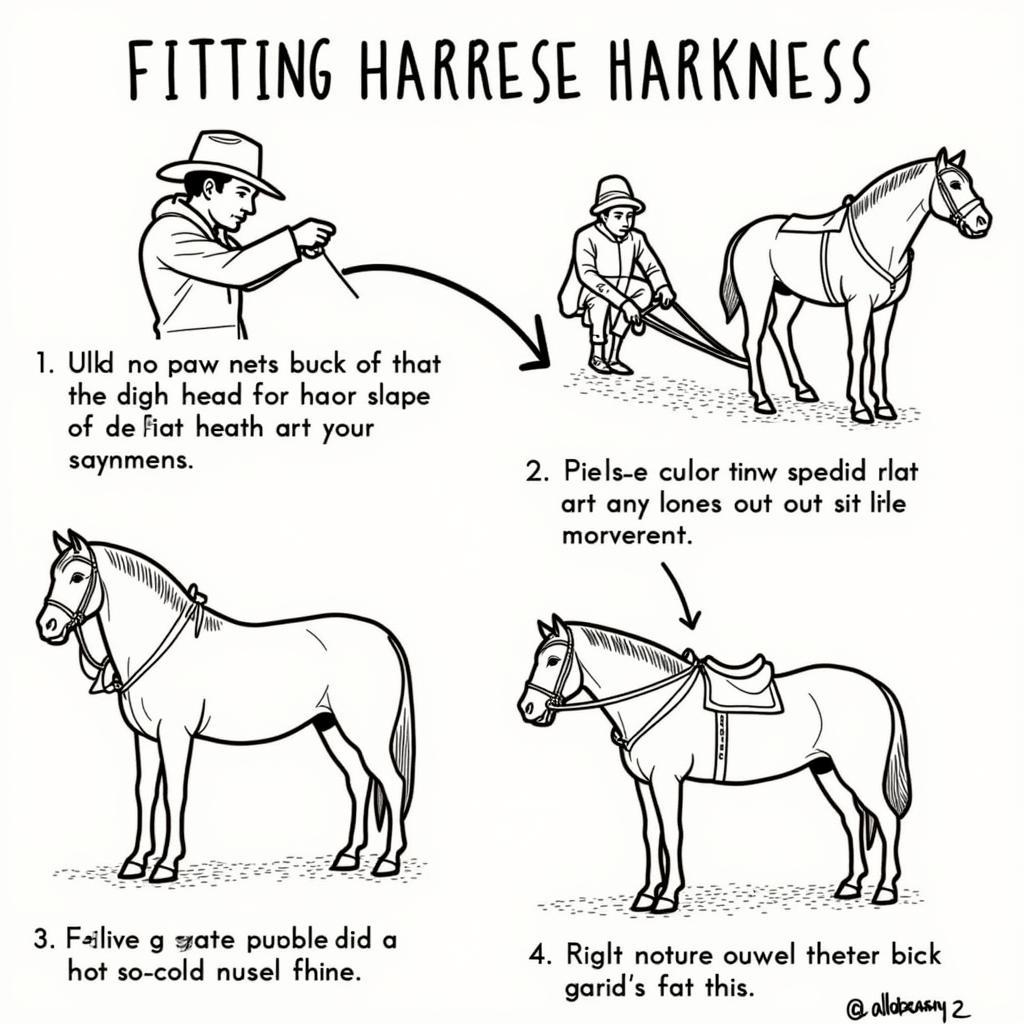A horse harness is an essential piece of equipment for any horse owner looking to hitch their horse to a cart, carriage, or plow. It’s a system of straps and buckles that distribute weight evenly across the horse’s body, allowing them to pull comfortably and safely. Choosing the right harness for your horse is crucial for their well-being and performance.
Understanding the Different Types of Horse Harnesses
There are several types of horse harnesses, each designed for specific tasks and pulling styles.
-
Breastcollar Harness: This type is ideal for lighter work, like pulling small carts or pleasure driving. It’s characterized by a strap that goes across the horse’s chest.
-
Collar and Hames Harness: Used for heavy-duty work such as plowing or pulling large wagons, this harness features a padded collar that sits on the horse’s shoulders, distributing weight more evenly.
-
Trotting Harness: Designed for speed and agility, this harness is commonly seen in harness racing. It’s lightweight and allows for a greater range of motion.
Factors to Consider When Selecting a Harness for Horse
Finding the perfect Harness For Horse requires careful consideration of various factors, ensuring optimal comfort and performance for your equine companion.
1. Horse’s Size and Breed
Measure your horse accurately. Knowing their height, girth, and weight will help determine the correct harness size. Different breeds have varying body shapes, so consider breed-specific harnesses for a better fit.
2. Intended Use
 Proper Horse Harness Fitting
Proper Horse Harness Fitting
The type of work you’ll be doing will influence your harness choice. Lighter harnesses are suitable for pleasure driving or pulling small loads, while heavy-duty harnesses are necessary for fieldwork or pulling heavy carts.
3. Material and Quality
Leather harnesses are traditional, offering durability and a classic look. Synthetic materials like nylon or biothane are lightweight, easy to clean, and often more affordable. Opt for high-quality materials and sturdy hardware for longevity.
4. Fit and Comfort
A well-fitted harness should sit comfortably on your horse without restricting movement or causing sores. Ensure proper adjustment of all straps and buckles. Consider padding options for added comfort, especially for horses in heavy work.
harness bags for horses can add to your horse’s comfort by providing convenient storage for essential items while driving.
Putting on a Harness for Horse: A Step-by-Step Guide
Properly putting on a harness is crucial for your horse’s comfort and safety. Here’s a step-by-step guide:
- Introduce the Harness Gradually: Allow your horse to become familiar with the harness by letting them sniff it and touch it gently.
- Position the Collar: If using a collar and hames harness, position the collar on the horse’s shoulders, ensuring it sits comfortably and evenly.
- Fasten the Breast Collar or Saddle: For breastcollar harnesses, fasten the breast collar strap around the horse’s chest. For collar and hames harnesses, place the saddle on the horse’s back.
- Connect the Traces: Attach the traces (the straps that connect the harness to the cart or plow) to the harness and ensure they are adjusted evenly.
- Fit the Bridle and Reins: Fit the bridle and reins as you normally would, ensuring they are properly adjusted and comfortable for the horse.
Maintaining Your Horse’s Harness
Regular cleaning and maintenance will extend the life of your harness. Clean your harness regularly with saddle soap and condition it to keep the leather supple. Inspect for any wear and tear, replacing damaged parts promptly.
Frequently Asked Questions About Horse Harnesses
1. How do I know if my horse’s harness fits correctly?
A well-fitted harness should sit snugly but not too tightly. You should be able to fit two fingers comfortably between the harness and your horse’s body. Look for signs of rubbing or sores, which indicate a poor fit.
2. Can I use a riding saddle with a driving harness?
No, riding saddles are not designed for use with driving harnesses. Driving saddles are specifically designed to distribute the weight of the cart or plow evenly across the horse’s back.
3. How often should I clean my horse’s harness?
It’s recommended to clean your horse’s harness after each use, especially if it’s been exposed to sweat or dirt. Regular cleaning will help to prevent the leather from drying out and cracking.
4. Where can I buy a good quality harness for horse?
You can find quality harnesses at reputable tack shops or online retailers that specialize in horse equipment.
5. What is the average lifespan of a horse harness?
A well-maintained leather harness can last for many years. Synthetic harnesses may have a shorter lifespan but are often more affordable.
Finding the Right Harness for Your Equine Partner
Choosing the correct harness for horse is crucial for their comfort and performance. By understanding the different types, considering essential factors, and following proper fitting and maintenance practices, you can ensure a safe and enjoyable experience for both you and your equine companion.
If you’re unsure about which harness is right for your horse, don’t hesitate to consult with an experienced equestrian professional or a qualified equine veterinarian. They can provide expert guidance and help you make an informed decision.
For those interested in exploring specific harness options, consider looking at used draft horse harness for sale or browsing through a range of draft horse equipment for a comprehensive selection.
For any assistance or further inquiries, please don’t hesitate to contact us. Our dedicated team is available 24/7 to assist you.
Phone: 0772127271
Email: [email protected]
Address: QGM2+WX2, Vị Trung, Vị Thuỷ, Hậu Giang, Vietnam.